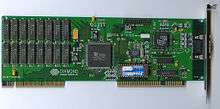Tseng Labs ET4000


The Tseng Labs ET4000 was a popular graphics accelerator chip during the early 1990s, commonly found in many 486 and compatible systems.
At introduction (1991), the original ET4000 was notable for its outstanding host-interface (ISA) throughput. Twice as fast as VGA-chips from Trident Microsystems and Oak Technologies, the ET4000's only superior was a VRAM-based board from Video 7 along with ATI's VGAWonder+. Hardware GUI acceleration had not yet become mainstream, and so host-throughput was the dominating factor in a graphical-application's redraw speed. Equipped with an ET4000, a raw Windows PC would scroll text-windows noticeably faster and more smoothly. (According to Richard Ferraro's book Programmer's Guide to EGA, VGA, the original ET4000 devoted as much as 30% of its silicon die area to a large host-interface FIFO.)
Hardware acceleration was introduced in the ET4000/W32. Although the W32 maintained Tseng's stellar host-interface throughput, hardware-acceleration reduced its importance (except for DOS). By the time PCI Windows accelerators became commonplace, Tseng's high host-throughput was no longer a distinguishing feature. Nevertheless, as a mid-priced Windows accelerator, the W32 benchmarked favorably against competing S3 and ATI chips. The ET4000AX had no 3D core or shader. It used 32 bit, asynchronous EDO/FPM (70 ns) DRAM which gave a transfer speed of ~56 MB/s.[1]
None of the members of the ET4000 family offered an integrated RAMDAC.[2] By the time the W32p was introduced, the lack of this feature harmed Tseng's competitiveness. Still, the W32p was used on several popular mid-range VLB-based video cards. W32p offered solid Windows GUI acceleration at a reasonable price, along with considerably competent DOS VGA performance. Tseng carried this DOS performance along with them with their later ET6000 accelerator.
Tseng Labs' chipsets were part of many companies' lineups, notably with Hercules' Dynamite series, the Diamond Stealth 32 and several Speedstar cards, and on many generic boards.
Models
- ET4000AX - Old ISA chipset, VLB OK (16-bit host interface, good response), up to 1MB video RAM.
- ET4000/W32 - Accelerated 32-bit host interface. 32-bit memory interface. Fair performance, comparable to Cirrus Logic CL-GD5426. Windows accelerator up to 2MB. Supported ISA, EISA, and VLB.
- ET4000/W32i - enhanced memory controller (32-bit wide with interleaving with 2MB — similar to S3 805i, resulting in 85% the performance of a plain 64-bit bus). Very fast BitBLTs (efficient memory arbitration).
- ET4000/W32p (1994) - PCI interface, also used with VLB. Special video support. Several revisions, significant variation. Revisions before C or D may have crippled/broken PCI performance.
References
- "PC Video Chipset Information" by Michael Scott & Harm Hanemaayer, February 19, 1997, retrieved January 2, 2006
- ↑ "Hattix.co.uk: Computer Hardware Museum". hattix.co.uk. 2008. Retrieved 2013-06-22.
- ↑ http://www.hattix.co.uk/hardware/index.php?page=video.html